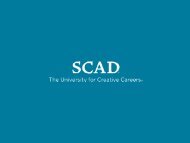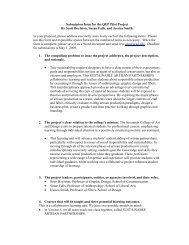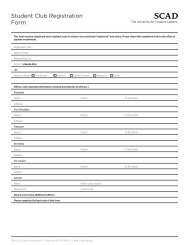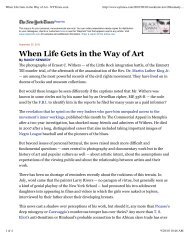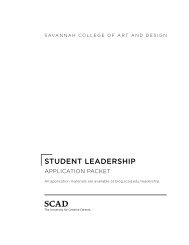Nicole Roberts MFA Thesis Visual Component Artwork - Savannah ...
Nicole Roberts MFA Thesis Visual Component Artwork - Savannah ...
Nicole Roberts MFA Thesis Visual Component Artwork - Savannah ...
Create successful ePaper yourself
Turn your PDF publications into a flip-book with our unique Google optimized e-Paper software.
EXPECTATION 4 | digital media<br />
Conversely, when surveyed on this topic, 60% of<br />
educators do not believe that print design and digital<br />
design should be treated equally within undergraduate<br />
graphic design curricula. The opposite is true for their<br />
students; 73% feel that with the direction technology<br />
is heading, print and digital design should be taught as<br />
equals within their curriculum. The dichotomy persists<br />
when educators and students were asked which aspects<br />
of their curriculum are emphasized the most. Digital<br />
media ranked second highest for educators, while<br />
students ranked it as the least emphasized within their<br />
current curriculum.<br />
It is undisputed that digital design education<br />
must be incorporated into collegiate graphic design<br />
programs. The problem remains that with this<br />
addition there are significant time constraints placed<br />
upon educators and more pressure placed upon<br />
students to master new media while concurrently<br />
developing a quality design project. Therefore, how<br />
technology is taught must change. Ideally in design<br />
education, technical proficiency comes prior to the<br />
application of these skills to extensive design problems.<br />
Students report that when expected to master the<br />
two simultaneously, the results were both technically<br />
and aesthetically below average. Ultimately, when<br />
the aesthetics within new media projects suffer, it<br />
is predominately due to poor technical proficiency.<br />
The solution for graphic design curricula resides in<br />
separating the two tracks of new media learning<br />
(technical versus conceptual/aesthetic) to ensure<br />
students are equally competent in both. A close<br />
comparison can be made in respect to international<br />
students who must first take an ‘English as a<br />
Second Language’ class in order to fully articulate<br />
and comprehend future coursework within their<br />
curriculum. They do not expect other professors in<br />
each of their core classes to teach them basic English<br />
comprehension in order to verbally communicate,<br />
just as students of graphic design cannot expect their<br />
design studio professors to spend time teaching them<br />
basic new media software techniques in order to<br />
visually communicate. Students must come to these<br />
courses equipped with a moderate level of technical<br />
knowledge. This is not to add yet another requirement<br />
to an already lengthy course list for graphic design<br />
majors. But curricula must publicly offer elective<br />
courses focused exclusively on mastering software<br />
immediately prior to each relevant studio class.<br />
This effort will serve to set the pre-requisite of<br />
acquiring a moderate level of experience with new<br />
media software prior to the design studio coursework.<br />
As a result, students will no longer be weighed down<br />
by a technical learning curve while they try to produce<br />
quality design projects, and educators will not feel<br />
compelled to lecture an entire class on software<br />
techniques. This solution will save time and energy<br />
by allowing both educators and students to focus<br />
more so on the critical thinking and aesthetics to<br />
solve the digital design problem. The field of graphic<br />
design will always be intrinsically linked to the tools<br />
and technology its practitioners use to create. But as<br />
technology is destined to continually reinvent itself,<br />
so must the skill set of its students. The opportunity<br />
for pedagogical change lies in promoting technical<br />
proficiency prior to design studio requirements,<br />
while continuing to exercise their new media skill<br />
sets throughout their educational career. Graphic<br />
design curricula must not allow students to become<br />
technologically complacent.<br />
We as educators have not taken<br />
web design and interactive media<br />
as seriously as other areas like<br />
typography and imaging.<br />
martha Scotford, Professor<br />
North Carolina State University<br />
Raleigh, North Carolina<br />
24




